
Wechat-AI-Assistant
微信AI助理 (Wechat AI Assistant): 在微信中与 AI 助理进行多模态交互, 处理问答、扮演角色、响应语音消息、分析图片和视频、总结文章和网页链接、搜索互联网等等。现支持 OpenAI Assistant API 和 GPT-4o模型。
Stars: 106
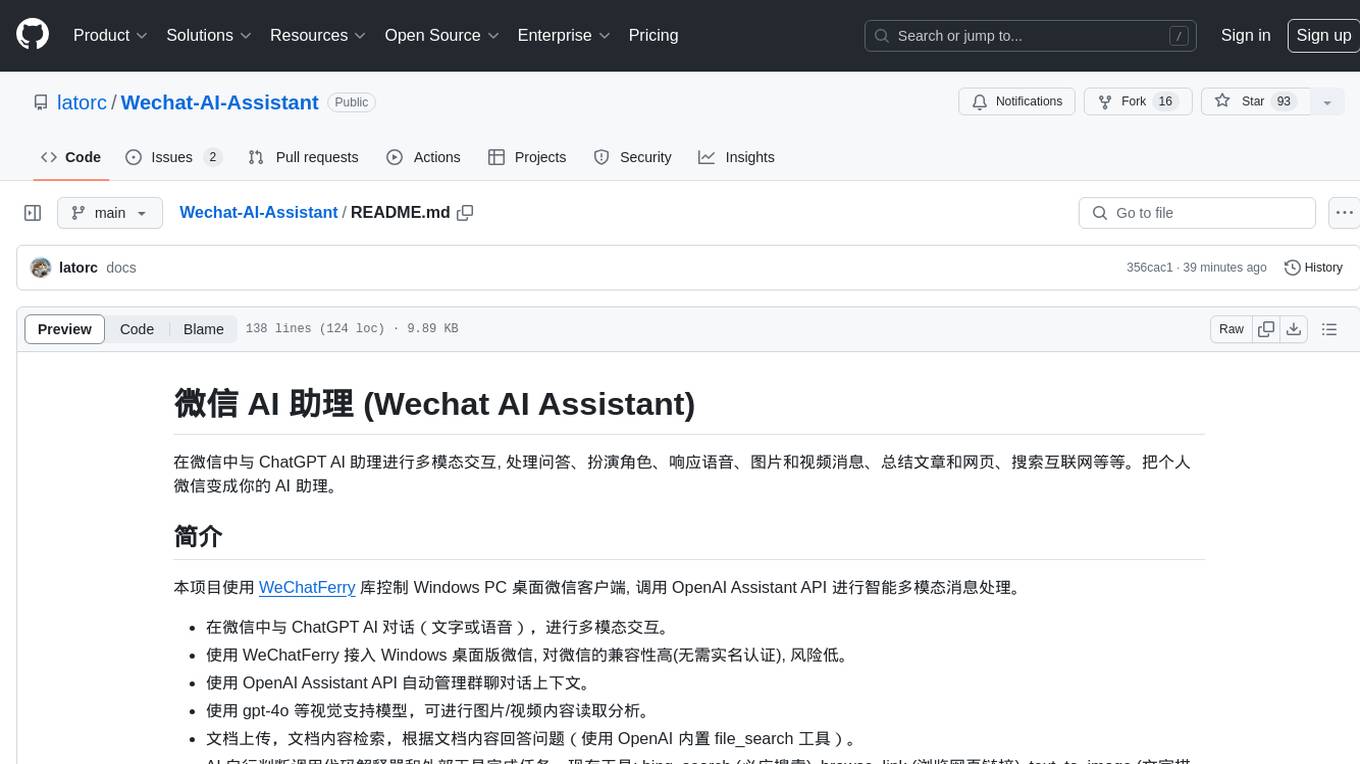
Wechat AI Assistant is a project that enables multi-modal interaction with ChatGPT AI assistant within WeChat. It allows users to engage in conversations, role-playing, respond to voice messages, analyze images and videos, summarize articles and web links, and search the internet. The project utilizes the WeChatFerry library to control the Windows PC desktop WeChat client and leverages the OpenAI Assistant API for intelligent multi-modal message processing. Users can interact with ChatGPT AI in WeChat through text or voice, access various tools like bing_search, browse_link, image_to_text, text_to_image, text_to_speech, video_analysis, and more. The AI autonomously determines which code interpreter and external tools to use to complete tasks. Future developments include file uploads for AI to reference content, integration with other APIs, and login support for enterprise WeChat and WeChat official accounts.
README:
在微信中与 ChatGPT AI 助理进行多模态交互, 处理问答、扮演角色、响应语音、图片和视频消息、总结文章和网页、搜索互联网等等。把个人微信变成你的 AI 助理。
本项目使用 WeChatFerry 库控制 Windows PC 桌面微信客户端, 调用 OpenAI Assistant API 进行智能多模态消息处理。
- 在微信中与 ChatGPT AI 对话(文字或语音),进行多模态交互。
- 使用 WeChatFerry 接入 Windows 桌面版微信, 对微信的兼容性高(无需实名认证), 风险低。
- 使用 OpenAI Assistant API 自动管理群聊对话上下文。
- 使用 gpt-4o 等视觉支持模型,可进行图片/视频内容读取分析。
- 文档上传,文档内容检索,根据文档内容回答问题(使用 OpenAI 内置 file_search 工具)。
- AI 自行判断调用代码解释器和外部工具完成任务。现有工具: bing_search (必应搜索), browse_link (浏览网页链接), text_to_image (文字描述作图), text_to_speech (文本转语音), mahjong_agari(立直麻将和牌计算:番数,符数,役种,点数等)
- 后续计划开发: 其他 API 和工具调用 / 企业微信和微信公众号登录
- QQ群: 812016253 点击加入
- 支持微信桌面客户端版本:3.9.10.27
- "画一张猫和水豚一起滑雪的照片"
- "(引用图片) 根据图片内容作一首诗,并读给我听"
- "(引用公众号文章或网页链接) 总结一下文章的要点"
- "搜索关于OPENAI的新闻, 把结果读给我听"
- "立直麻将手牌 1112345678999m 自摸0m,和什么役种和点数?"
- OpenAI API Key 注: 本项目依赖于 Assistant API,非官方的 API 入口请确认是否支持 Assistant API。
- Windows 电脑或服务器。
- (可选, 中国国内) 访问 OpenAI 的代理服务器 (例如 openai-proxy), 或者使用 API 代理。
- (可选,手动部署需要) 安装好 Python 环境和 Git
- (可选, 供联网搜索插件使用) Bing Search API Key. 获取地址
- 到 Releases 中下载打包好的可执行文件和微信安装文件
- 安装微信 Windows 桌面指定版本 (安装包已提供)。
- 将压缩包解压到本地。
- 编辑 config.yaml 文件(必填项目为openai api_key,配置项说明见文档。)
- 运行"main.exe", 程序将唤起微信客户端, 登录后程序开始运行。
- 安装微信Windows指定版本版本。请到 Release 中下载。
- 克隆项目代码到本地
git clone https://github.com/latorc/Wechat-AI-Assistant.git- (可选) 创建 Python 虚拟环境并激活
python -m venv .venv
call .venv\Scripts\activate.bat- 安装依赖的库; 这里使用清华的来源, 方便中国国内用户快速下载
cd Wechat-AI-Assistant
pip install -r requirements.txt -i https://pypi.tuna.tsinghua.edu.cn/simple- 编辑配置文件: 重命名配置文件 config_template.yaml 为 config.yaml, 并编辑配置项。配置项说明见文档。
- 运行 main.py
python main.py程序会自动唤起微信客户端, 之后扫码登录微信桌面客户端, 即可开始使用。
| 配置项 | 说明 | 举例 |
|---|---|---|
| api_key | 你的 OpenAI API Key | sk-abcdefg12345678.... |
| base_url | API 的网址, 使用默认 API 无需改动, 使用代理或第三方 API 时填写 | https://api.openai.com/v1 |
| proxy | 用于访问 OpenAI 的代理服务器地址, 格式为"http://地址:端口号" | http://10.0.0.10:8002 |
| chat_model | 默认使用的聊天模型 | gpt-4o |
| admins | 管理员微信号列表, 只有管理员可以使用管理员命令 | [wx1234, wx2345] |
其他配置选项请参见 config.yaml 中的注释。
- 添加微信AI助理的微信好友, 或将其加入群聊中并@它, 与它进行对话。
- 直接与其对话将调用 ChatGPT 进行回答。可以发送图片和文件后, 引用图片和文件并@AI助理, 指示其进行处理。
- 微信AI助理会根据用户的文本, 自主选择调用工具完成任务。现阶段工具包括绘图(OpenAI dall-e-3), 代码解释器, 合成语音(OpenAI API), 访问网页, 搜索等。
- 绘图质量暂时由 AI 控制
- 只支持指定版本微信,请在设置中关闭微信自动更新。运行前请关闭打开的微信桌面客户端。
定义了管理员后 (config.yaml 文件中的 admins 项目), 管理员可以使用管理员命令。默认的命令如下:
| 命令 | 说明 |
|---|---|
| $帮助 | 显示帮助信息 |
| $刷新配置 | 重新载入程序配置 |
| $清除 | 清除当前对话记忆 |
| $加载<预设名> | 为当前对话加载预设 |
| $重置预设 | 为当前对话重置预设到默认预设 |
| $预设列表 | 显示可用的预设 |
| $id | 显示当前对话的id |
这些命令可以在 config.yaml 中修改
- 对话预设是对当前对话(群聊或单聊)生效的系统提示词和消息包装方式。
- 对AI助理使用默认命令"$加载 <预设名>"可以为当前对话加载预设。"$预设列表"命令显示当前可用的预设及其描述。
- <预设名>为定义在 presets 目录下的同名 yaml 配置文件。
- default.yaml 是默认预设, 对话默认使用。
- 可以用配置文件中的 group_presets 字段,为对话设置预设,程序启动时自动加载。
- 要创建自己的预设, 请参考 presets 目录下的 default.yaml, 即默认的预设。复制该文件,改名成你的预设名称,并修改其中信息。
- desc: 预设的简单描述
- sys_prompt: 预设的系统提示词
- msg_format: 包装用户消息的格式字符串, 可用替换变量 {message}=原消息, {wxcode}=发送者微信号, {nickname}=发送者微信昵称。如不设置则直接发送源消息。
- 工具代表外部函数和 API, 可以供 AI 模型自主选择调用, 来完成额外任务, 如画图, 联网搜索等功能。
- 使用 "$帮助" 命令显示启用的工具插件。
- 工具配置: 在 config.yaml 中的 tools 字段, 定义了工具是否启用, 以及工具的配置选项。要禁用工具, 只需删除或者注释掉插件名。某些插件需要额外配置选项才能工作, 比如 bing_search (必应搜索) 需要 api_key 才能工作。
- 每个工具在 Assistant 中对应一个 Function Tool, 可以在 OpenAI Playground 查看。
- 工具代码位于 tools 目录下, 继承 ToolBase 类并实现接口。
工具介绍:
- bing_search (必应搜索): 使用微软 Bing Search API 搜索互联网上的内容。
- 注册获取 Bing search API 见: https://www.microsoft.com/bing/apis/bing-web-search-api
- browse_link: 浏览网页链接。使用 Selenium 获取网页文字内容供 AI 使用。
- text_to_image: 文本作图。 使用 dall-e 模型根据文字生成图片。
- text_to_speech: 文本转语音。使用 OpenAI API 从文本生成语音音频。
- audio_transcript: 语音转文本。使用 OpenAI Whipser 将语音转录成文本。
- mahjong_agari: 日麻点和牌点数计算。计算役种,番数符数,点数等信息。使用库: https://github.com/MahjongRepository/mahjong
- 在国内无法连接官方 API 时, 可以尝试使用 API 代理, 或者使用科学上网代理。一个免费的 API 代理是openai-proxy.com, 将 base_url 替换成 https://api.openai-proxy.com/v1
- 可以使用手机模拟器 (如逍遥模拟器) 登录微信, 并登录 Windows 微信客户端, 即可保持微信持续在线。不要打断模拟器的扫码过程,可能会触发微信检测封号。
- 程序调用了 OpenAI 的 Assistant API. 运行时,程序将创建并修改一个名为 "Wechat_AI_Assistant" 的 assistant 用于对话。你可以在 OpenAI Playground 测试这个助理。
- 程序会上传照片和文件到 OpenAI 进行处理。你可以在 OpenAI管理后台查看和删除你的文件。OpenAI 不对文件本身进行收费,但是对文件的总占用空间有限制。
- 程序把所有工具的定义描述, 搜索结果和网页全文都发给 OpenAI。需要节省 token 可以关闭部分工具(插件)。
- QQ群: 812016253 点击加入
- 鸣谢: 本项目基于 WeChatFerry. 感谢 lich0821 大佬的 WeChatFerry 项目
- 推荐: 一键部署自己的ChatGPT网站 ChatGPT-Next-Web 项目
- 参考: 使用网页版微信登录的微信机器人 ChatGPT-on-Wechat 项目
- 参考: OpenAI Cookbook 博客教程 Assistant API Overview
- 参考: OpenAI API Reference
For Tasks:
Click tags to check more tools for each tasksFor Jobs:
Alternative AI tools for Wechat-AI-Assistant
Similar Open Source Tools

Wechat-AI-Assistant
Wechat AI Assistant is a project that enables multi-modal interaction with ChatGPT AI assistant within WeChat. It allows users to engage in conversations, role-playing, respond to voice messages, analyze images and videos, summarize articles and web links, and search the internet. The project utilizes the WeChatFerry library to control the Windows PC desktop WeChat client and leverages the OpenAI Assistant API for intelligent multi-modal message processing. Users can interact with ChatGPT AI in WeChat through text or voice, access various tools like bing_search, browse_link, image_to_text, text_to_image, text_to_speech, video_analysis, and more. The AI autonomously determines which code interpreter and external tools to use to complete tasks. Future developments include file uploads for AI to reference content, integration with other APIs, and login support for enterprise WeChat and WeChat official accounts.
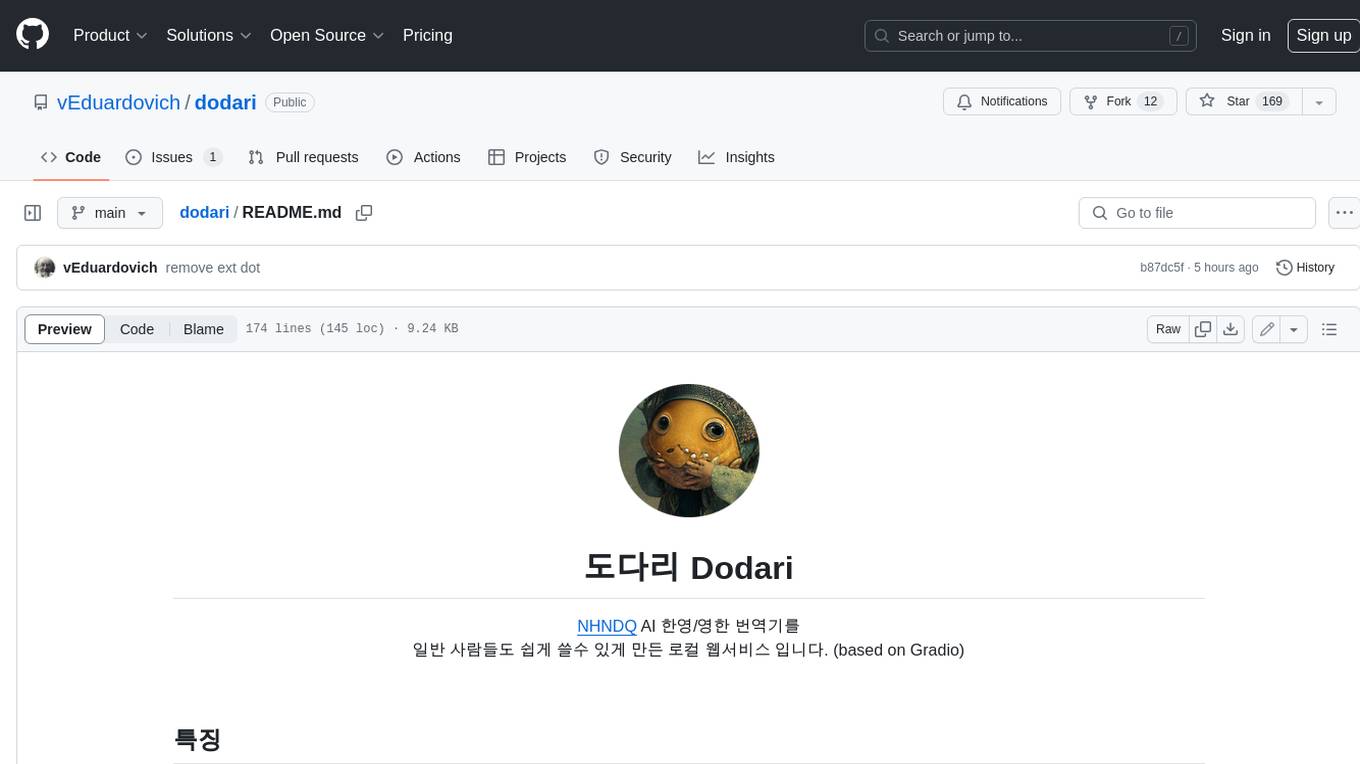
dodari
Dodari is a local web service that makes NHNDQ AI Korean-English/English-Korean translation easy for everyday people to use (based on Gradio).
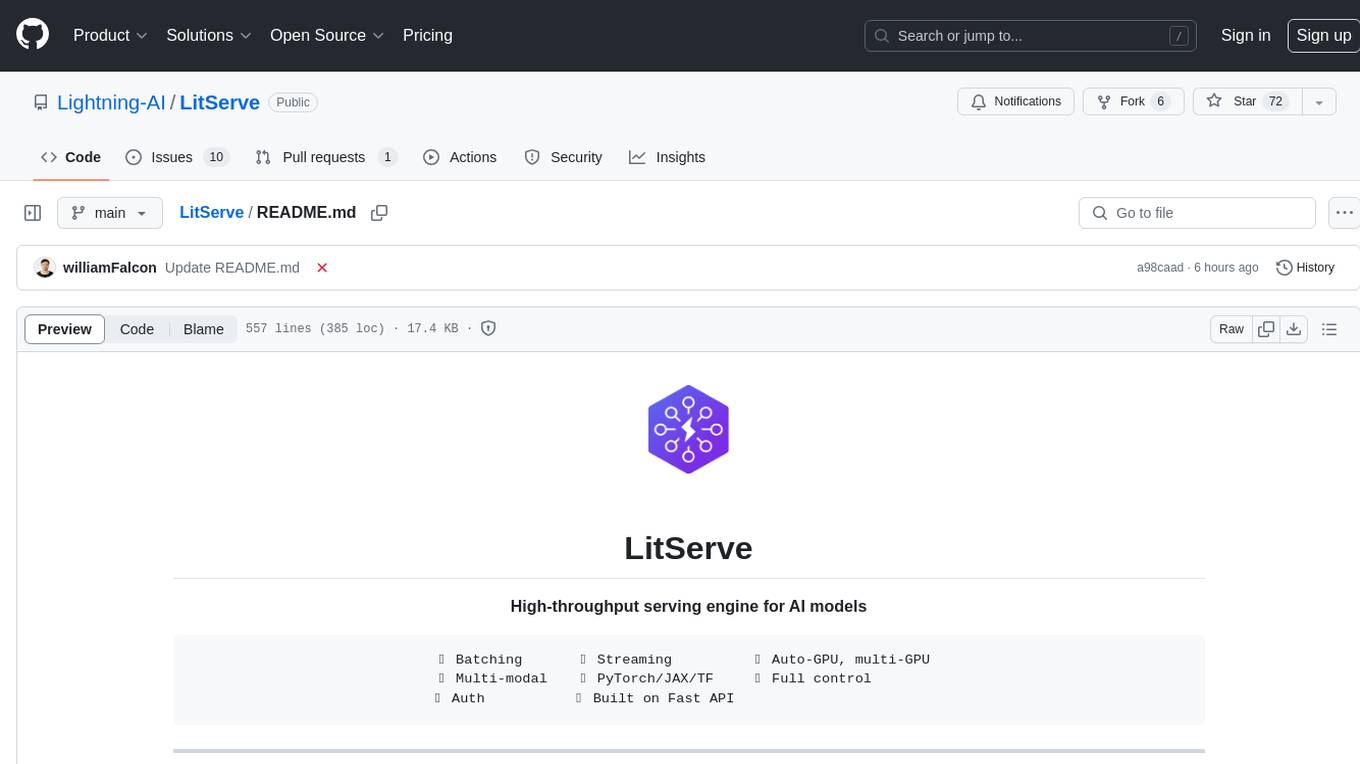
LitServe
LitServe is a high-throughput serving engine designed for deploying AI models at scale. It generates an API endpoint for models, handles batching, streaming, and autoscaling across CPU/GPUs. LitServe is built for enterprise scale with a focus on minimal, hackable code-base without bloat. It supports various model types like LLMs, vision, time-series, and works with frameworks like PyTorch, JAX, Tensorflow, and more. The tool allows users to focus on model performance rather than serving boilerplate, providing full control and flexibility.
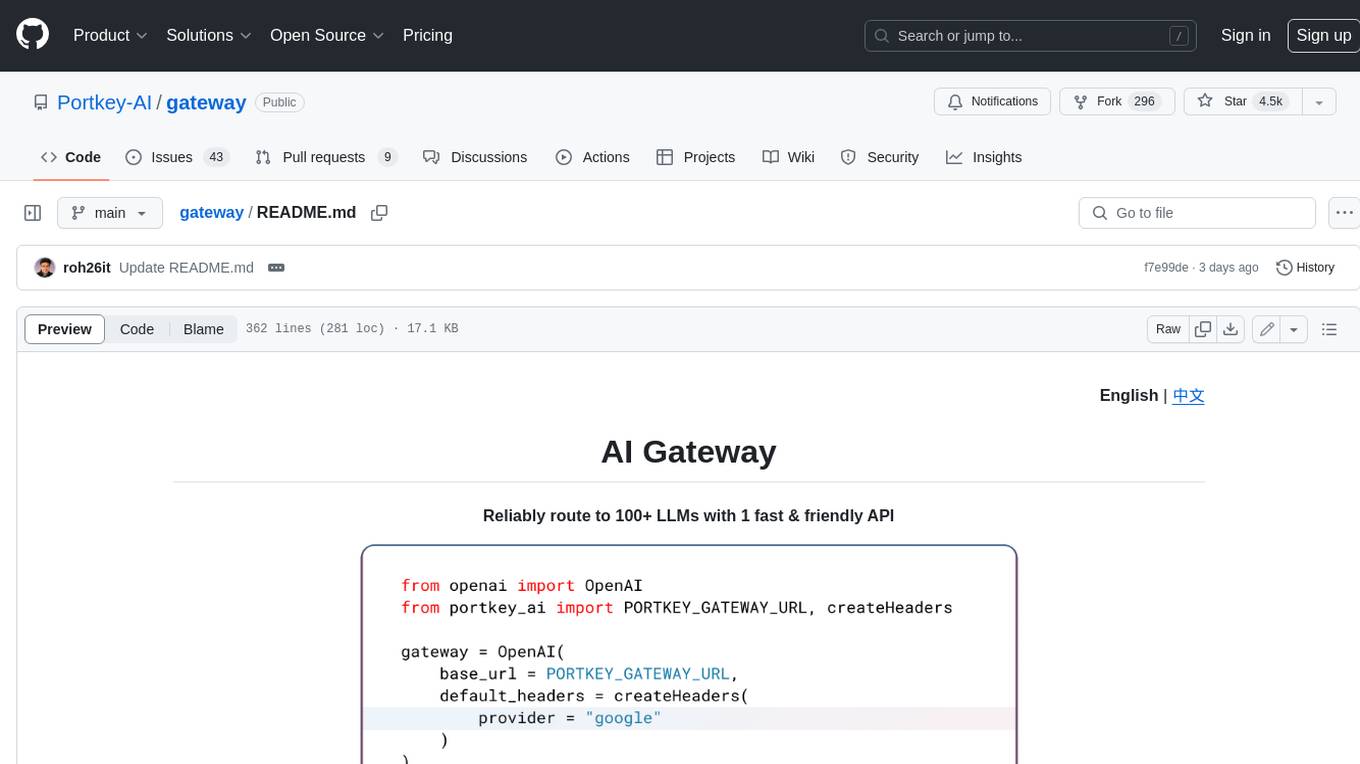
gateway
Gateway is a tool that streamlines requests to 100+ open & closed source models with a unified API. It is production-ready with support for caching, fallbacks, retries, timeouts, load balancing, and can be edge-deployed for minimum latency. It is blazing fast with a tiny footprint, supports load balancing across multiple models, providers, and keys, ensures app resilience with fallbacks, offers automatic retries with exponential fallbacks, allows configurable request timeouts, supports multimodal routing, and can be extended with plug-in middleware. It is battle-tested over 300B tokens and enterprise-ready for enhanced security, scale, and custom deployments.
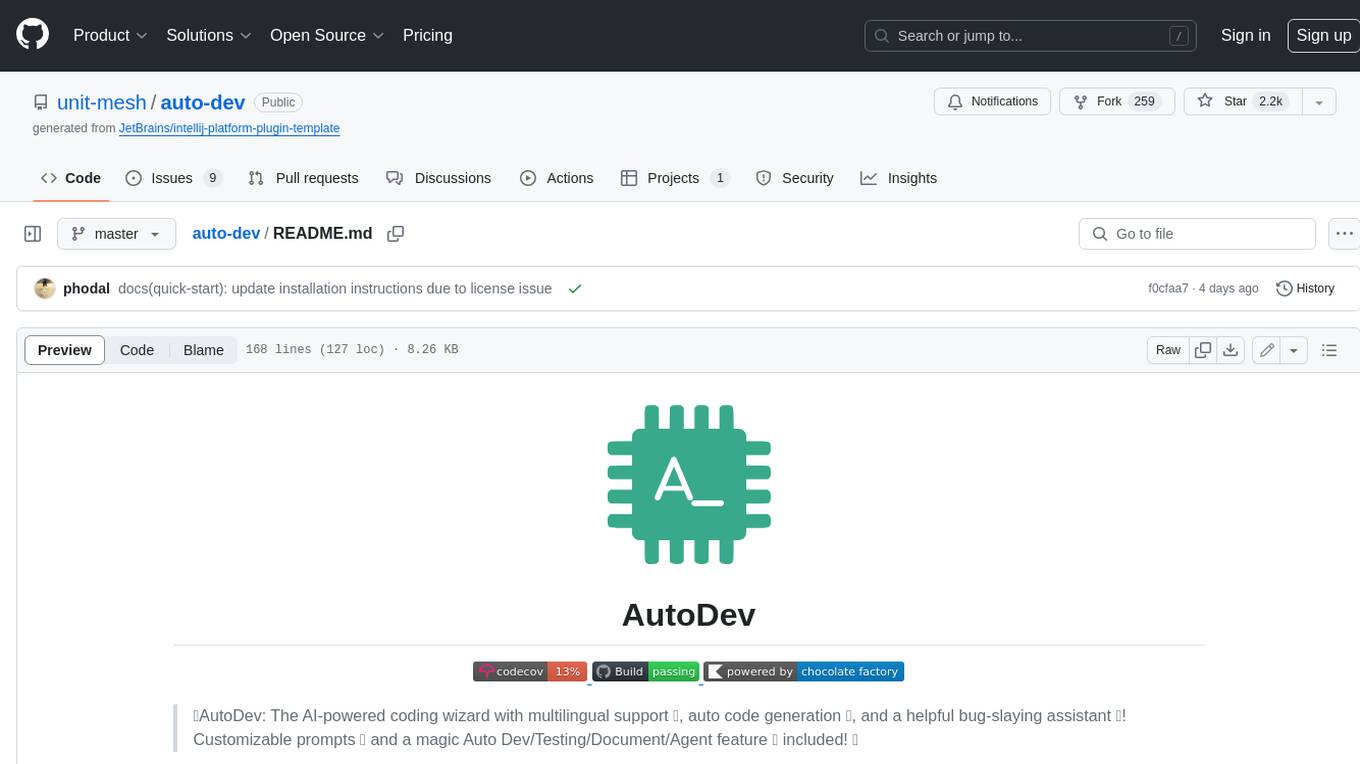
auto-dev
AutoDev is an AI-powered coding wizard that supports multiple languages, including Java, Kotlin, JavaScript/TypeScript, Rust, Python, Golang, C/C++/OC, and more. It offers a range of features, including auto development mode, copilot mode, chat with AI, customization options, SDLC support, custom AI agent integration, and language features such as language support, extensions, and a DevIns language for AI agent development. AutoDev is designed to assist developers with tasks such as auto code generation, bug detection, code explanation, exception tracing, commit message generation, code review content generation, smart refactoring, Dockerfile generation, CI/CD config file generation, and custom shell/command generation. It also provides a built-in LLM fine-tune model and supports UnitEval for LLM result evaluation and UnitGen for code-LLM fine-tune data generation.
aiconfigurator
The `aiconfigurator` tool assists in finding a strong starting configuration for disaggregated serving in AI deployments. It helps optimize throughput at a given latency by evaluating thousands of configurations based on model, GPU count, and GPU type. The tool models LLM inference using collected data for a target machine and framework, running via CLI and web app. It generates configuration files for deployment with Dynamo, offering features like customized configuration, all-in-one automation, and tuning with advanced features. The tool estimates performance by breaking down LLM inference into operations, collecting operation execution times, and searching for strong configurations. Supported features include models like GPT and operations like attention, KV cache, GEMM, AllReduce, embedding, P2P, element-wise, MoE, MLA BMM, TRTLLM versions, and parallel modes like tensor-parallel and pipeline-parallel.
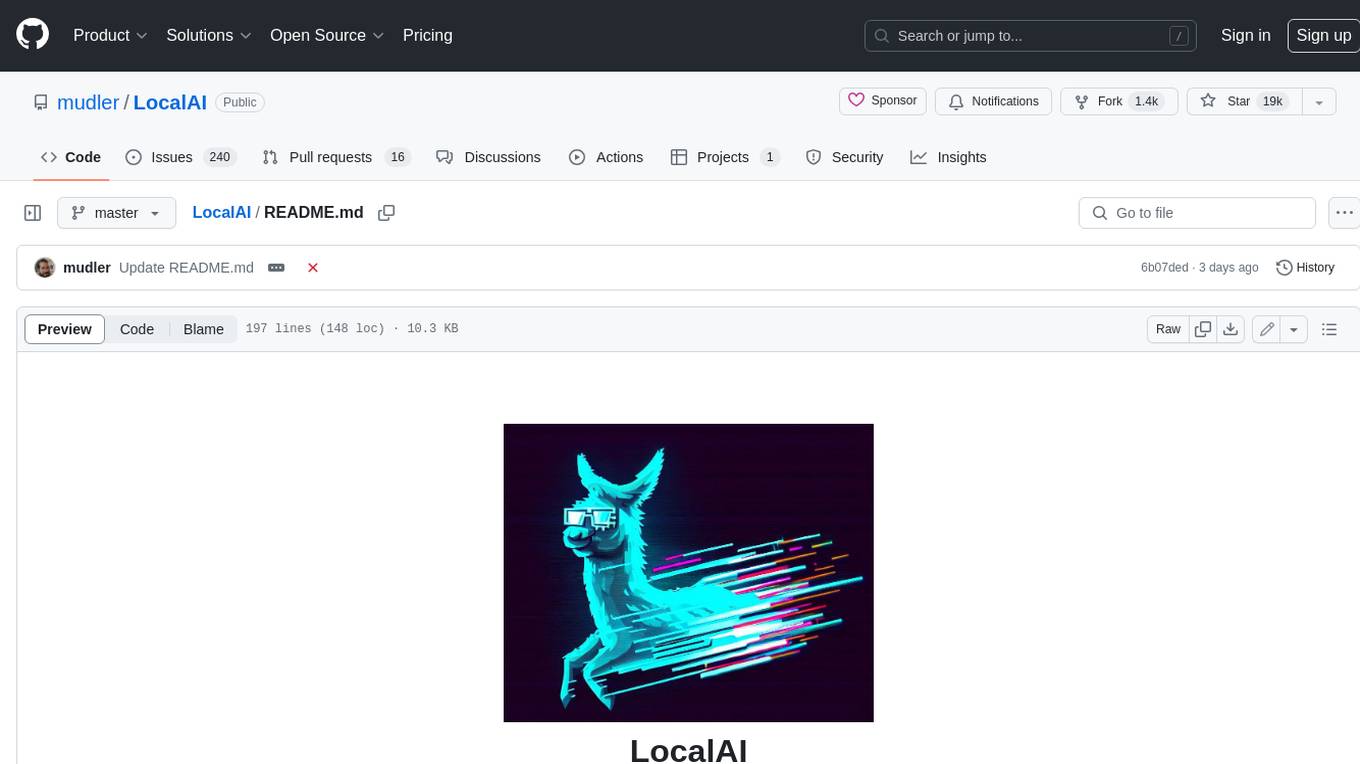
LocalAI
LocalAI is a free and open-source OpenAI alternative that acts as a drop-in replacement REST API compatible with OpenAI (Elevenlabs, Anthropic, etc.) API specifications for local AI inferencing. It allows users to run LLMs, generate images, audio, and more locally or on-premises with consumer-grade hardware, supporting multiple model families and not requiring a GPU. LocalAI offers features such as text generation with GPTs, text-to-audio, audio-to-text transcription, image generation with stable diffusion, OpenAI functions, embeddings generation for vector databases, constrained grammars, downloading models directly from Huggingface, and a Vision API. It provides a detailed step-by-step introduction in its Getting Started guide and supports community integrations such as custom containers, WebUIs, model galleries, and various bots for Discord, Slack, and Telegram. LocalAI also offers resources like an LLM fine-tuning guide, instructions for local building and Kubernetes installation, projects integrating LocalAI, and a how-tos section curated by the community. It encourages users to cite the repository when utilizing it in downstream projects and acknowledges the contributions of various software from the community.
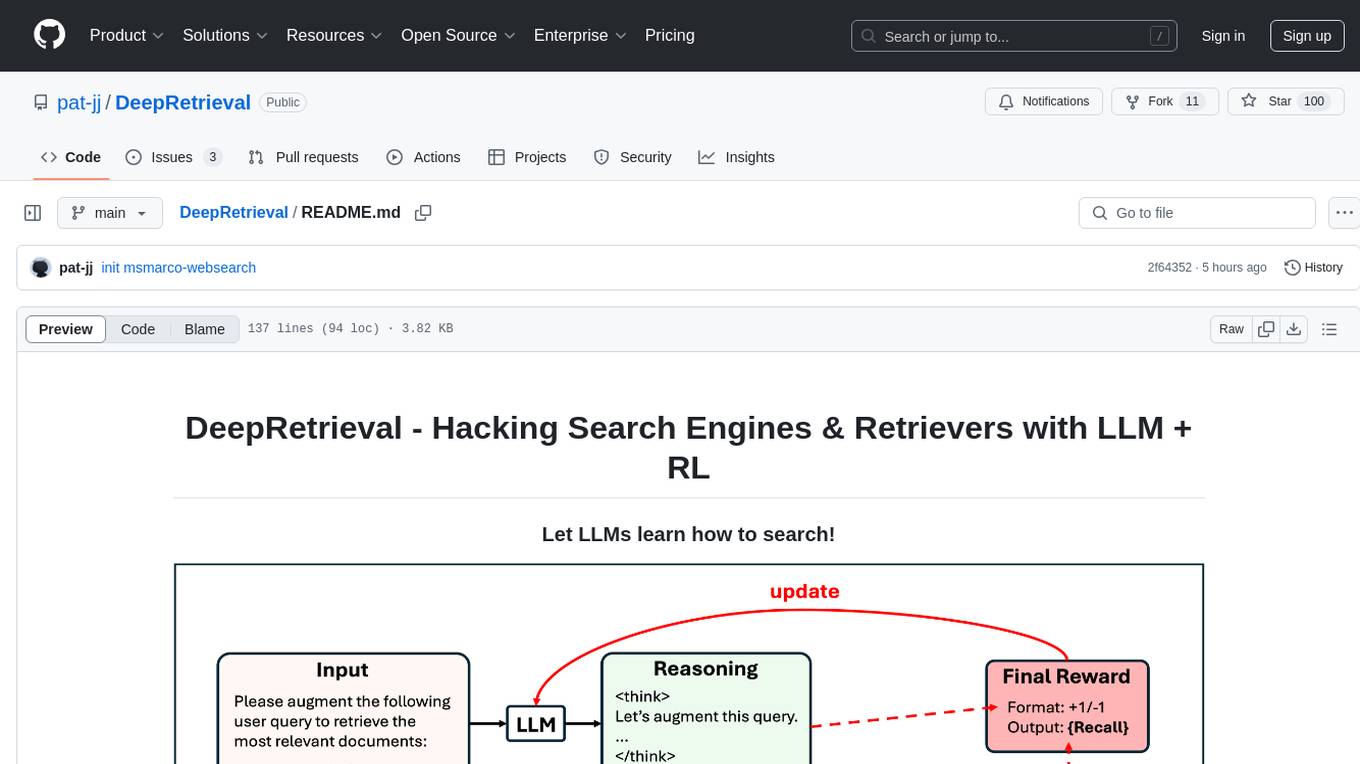
DeepRetrieval
DeepRetrieval is a tool designed to enhance search engines and retrievers using Large Language Models (LLMs) and Reinforcement Learning (RL). It allows LLMs to learn how to search effectively by integrating with search engine APIs and customizing reward functions. The tool provides functionalities for data preparation, training, evaluation, and monitoring search performance. DeepRetrieval aims to improve information retrieval tasks by leveraging advanced AI techniques.
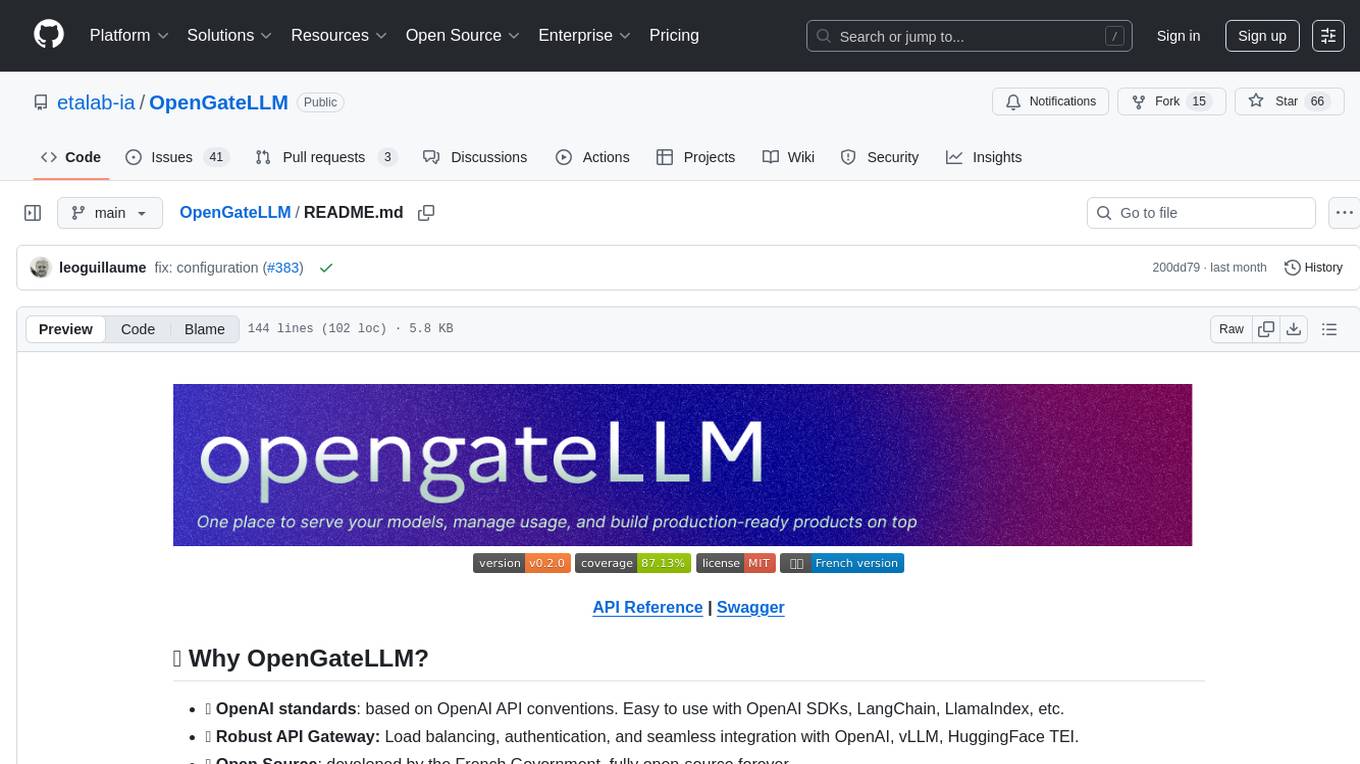
OpenGateLLM
OpenGateLLM is an open-source API gateway developed by the French Government, designed to serve AI models in production. It follows OpenAI standards and offers robust features like RAG integration, audio transcription, OCR, and more. With support for multiple AI backends and built-in security, OpenGateLLM provides a production-ready solution for various AI tasks.
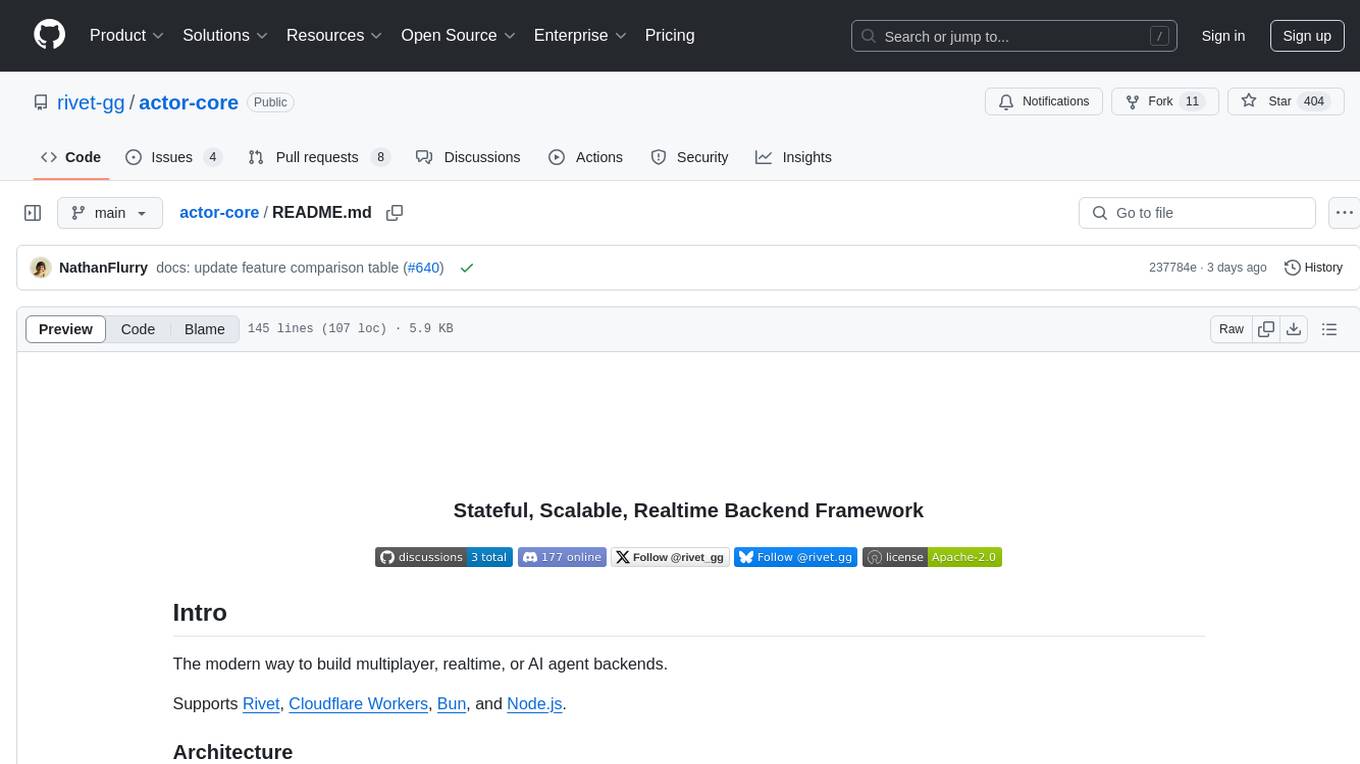
actor-core
Actor-core is a lightweight and flexible library for building actor-based concurrent applications in Java. It provides a simple API for creating and managing actors, as well as handling message passing between actors. With actor-core, developers can easily implement scalable and fault-tolerant systems using the actor model.
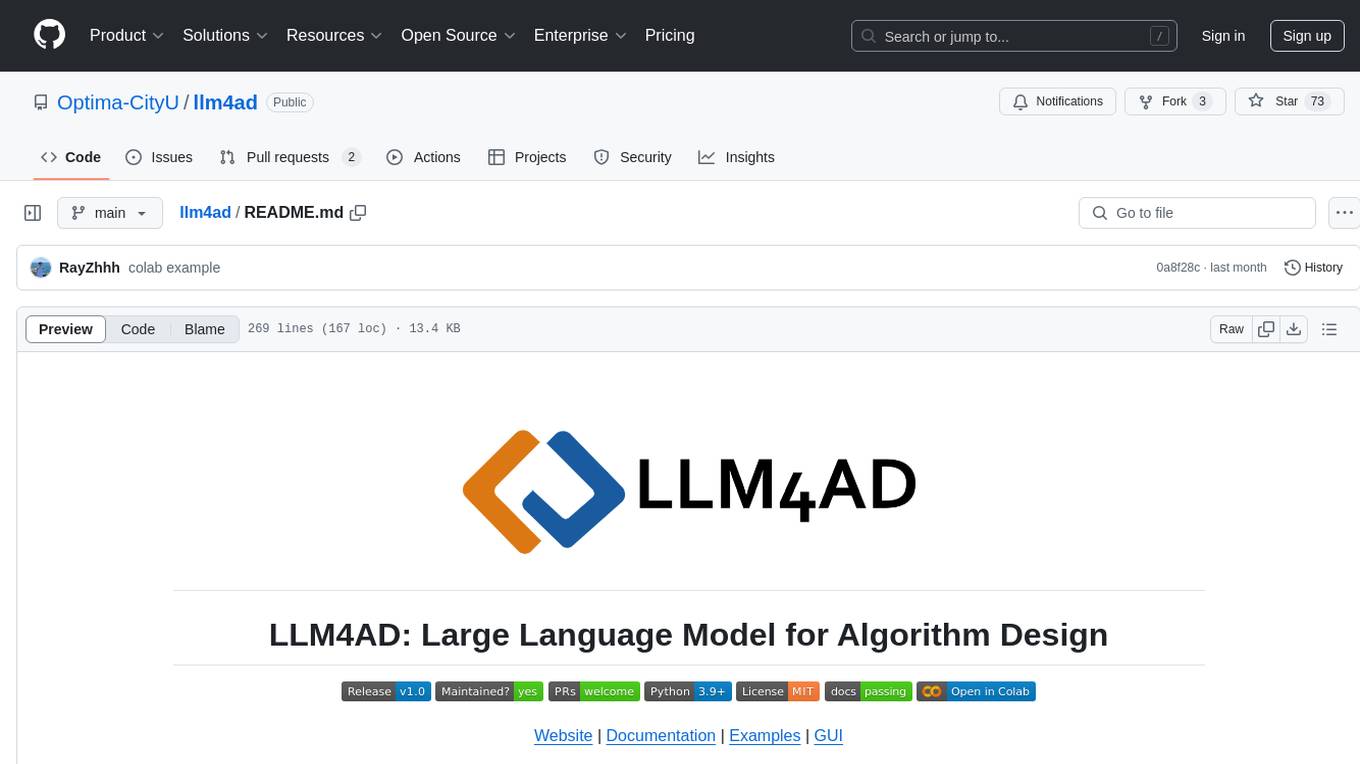
llm4ad
LLM4AD is an open-source Python-based platform leveraging Large Language Models (LLMs) for Automatic Algorithm Design (AD). It provides unified interfaces for methods, tasks, and LLMs, along with features like evaluation acceleration, secure evaluation, logs, GUI support, and more. The platform was originally developed for optimization tasks but is versatile enough to be used in other areas such as machine learning, science discovery, game theory, and engineering design. It offers various search methods and algorithm design tasks across different domains. LLM4AD supports remote LLM API, local HuggingFace LLM deployment, and custom LLM interfaces. The project is licensed under the MIT License and welcomes contributions, collaborations, and issue reports.
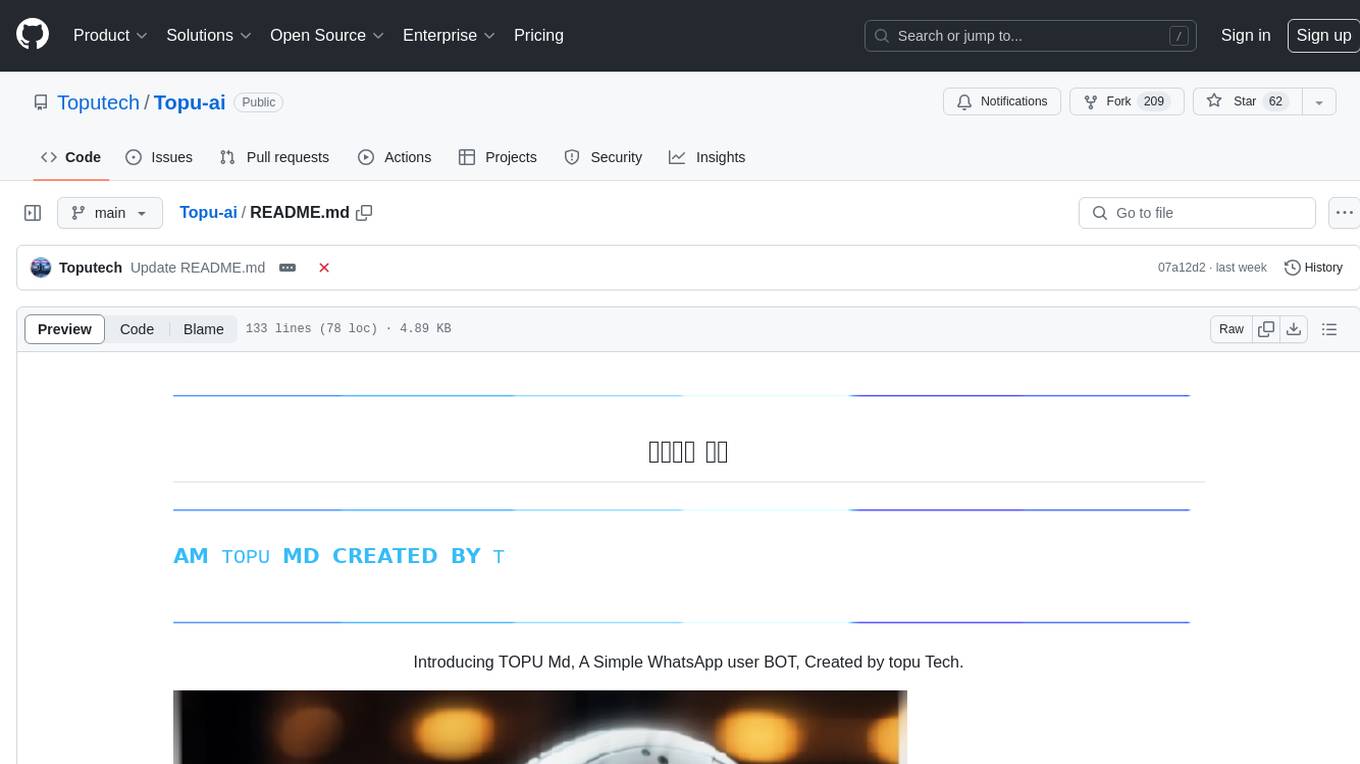
Topu-ai
TOPU Md is a simple WhatsApp user bot created by Topu Tech. It offers various features such as multi-device support, AI photo enhancement, downloader commands, hidden NSFW commands, logo commands, anime commands, economy menu, various games, and audio/video editor commands. Users can fork the repo, get a session ID by pairing code, and deploy on Heroku. The bot requires Node version 18.x or higher for optimal performance. Contributions to TOPU-MD are welcome, and the tool is safe for use on WhatsApp and Heroku. The tool is licensed under the MIT License and is designed to enhance the WhatsApp experience with diverse features.
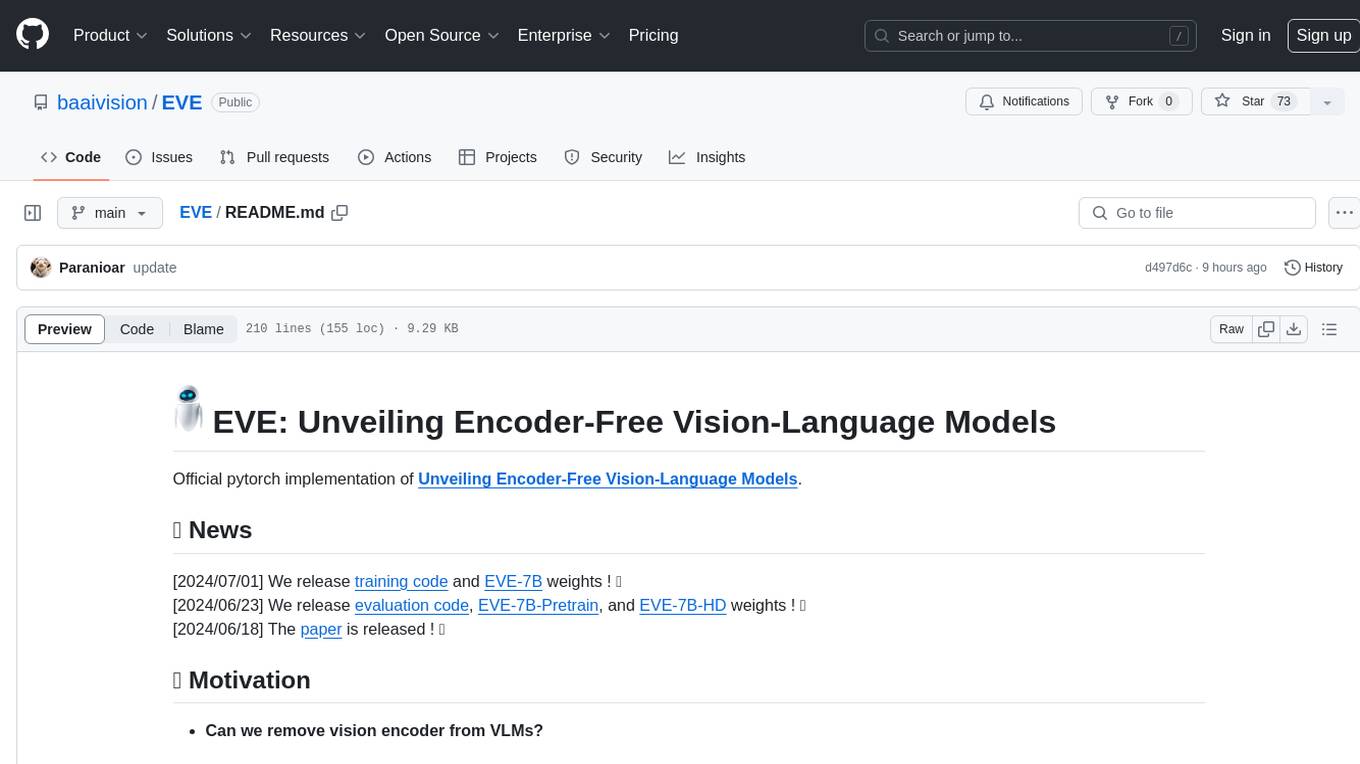
EVE
EVE is an official PyTorch implementation of Unveiling Encoder-Free Vision-Language Models. The project aims to explore the removal of vision encoders from Vision-Language Models (VLMs) and transfer LLMs to encoder-free VLMs efficiently. It also focuses on bridging the performance gap between encoder-free and encoder-based VLMs. EVE offers a superior capability with arbitrary image aspect ratio, data efficiency by utilizing publicly available data for pre-training, and training efficiency with a transparent and practical strategy for developing a pure decoder-only architecture across modalities.

tt-metal
TT-NN is a python & C++ Neural Network OP library. It provides a low-level programming model, TT-Metalium, enabling kernel development for Tenstorrent hardware.
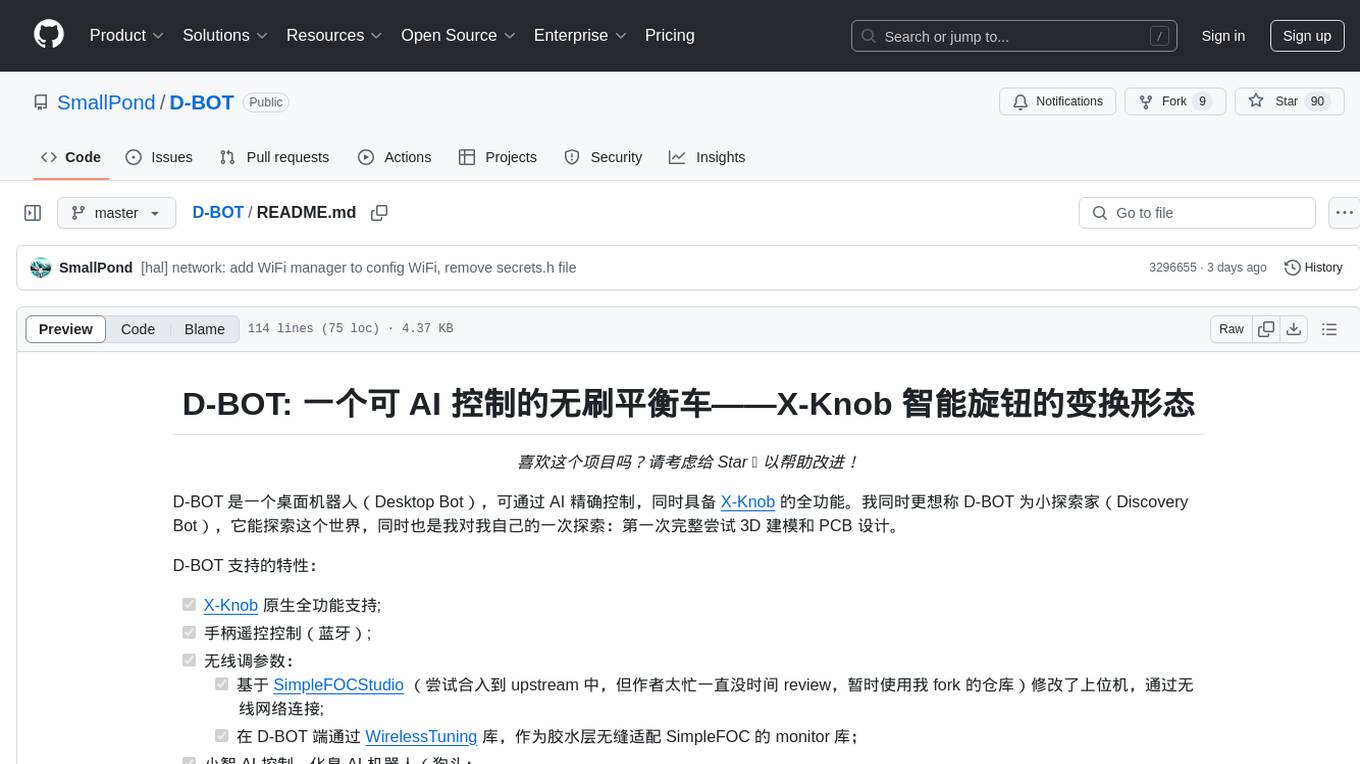
D-BOT
D-BOT is a desktop robot controlled by AI, featuring full functionality of X-Knob. It supports X-Knob native support, remote control via Bluetooth, wireless parameter tuning, and AI control. The project also includes 3D modeling and PCB design. The hardware includes 4 PCBs, ESP32-S3 MCU, circular LCD screen, magnetic encoder, and brushless DC motor. The 3D printed parts consist of chassis, wheel adapter, battery buckle, screen frame, and support. The tool can be set up using VScode + PlatformIO, and allows wireless tuning through SimpleFOCStudio. The project is inspired by Super_Balance open-source balance car project.
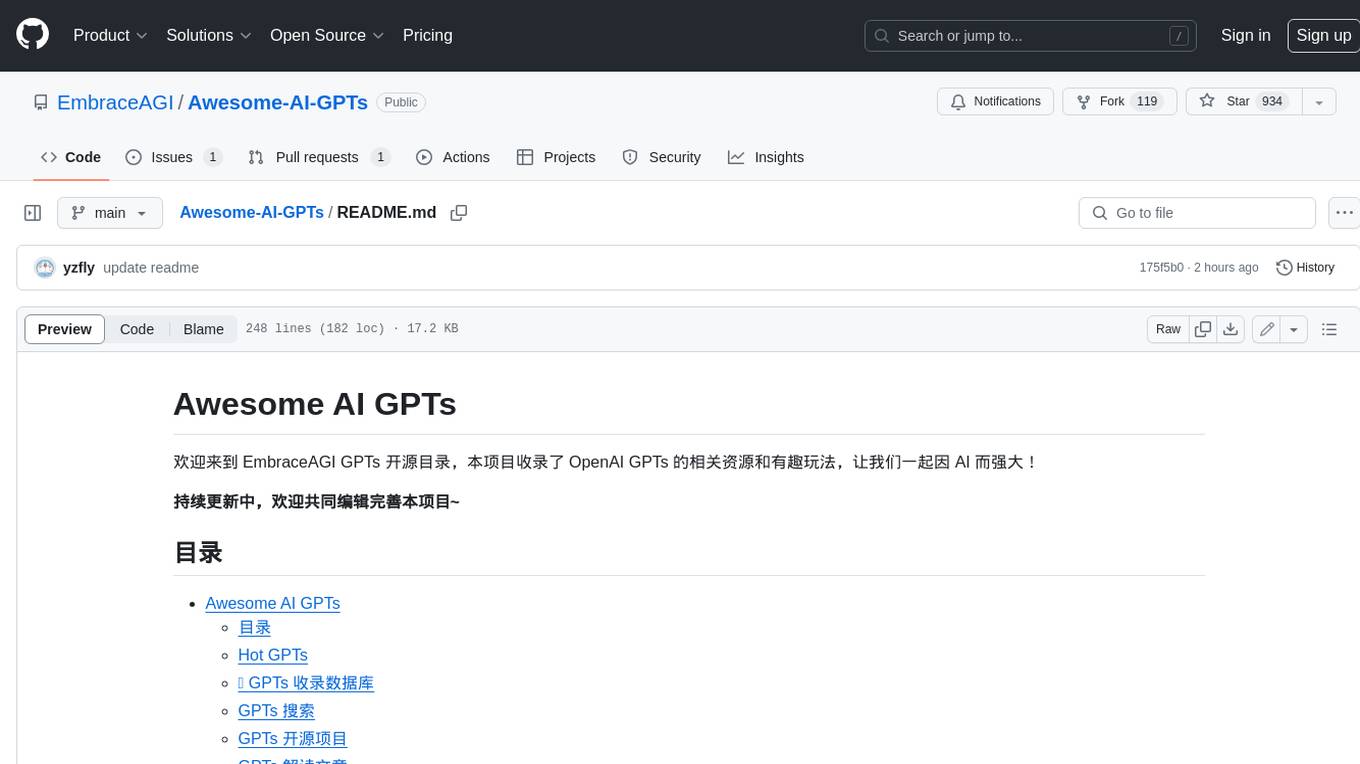
Awesome-AI-GPTs
Awesome AI GPTs is an open repository that collects resources and fun ways to use OpenAI GPTs. It includes databases, search tools, open-source projects, articles, attack and defense strategies, installation of custom plugins, knowledge bases, and community interactions related to GPTs. Users can find curated lists, leaked prompts, and various GPT applications in this repository. The project aims to empower users with AI capabilities and foster collaboration in the AI community.
For similar tasks

Wechat-AI-Assistant
Wechat AI Assistant is a project that enables multi-modal interaction with ChatGPT AI assistant within WeChat. It allows users to engage in conversations, role-playing, respond to voice messages, analyze images and videos, summarize articles and web links, and search the internet. The project utilizes the WeChatFerry library to control the Windows PC desktop WeChat client and leverages the OpenAI Assistant API for intelligent multi-modal message processing. Users can interact with ChatGPT AI in WeChat through text or voice, access various tools like bing_search, browse_link, image_to_text, text_to_image, text_to_speech, video_analysis, and more. The AI autonomously determines which code interpreter and external tools to use to complete tasks. Future developments include file uploads for AI to reference content, integration with other APIs, and login support for enterprise WeChat and WeChat official accounts.
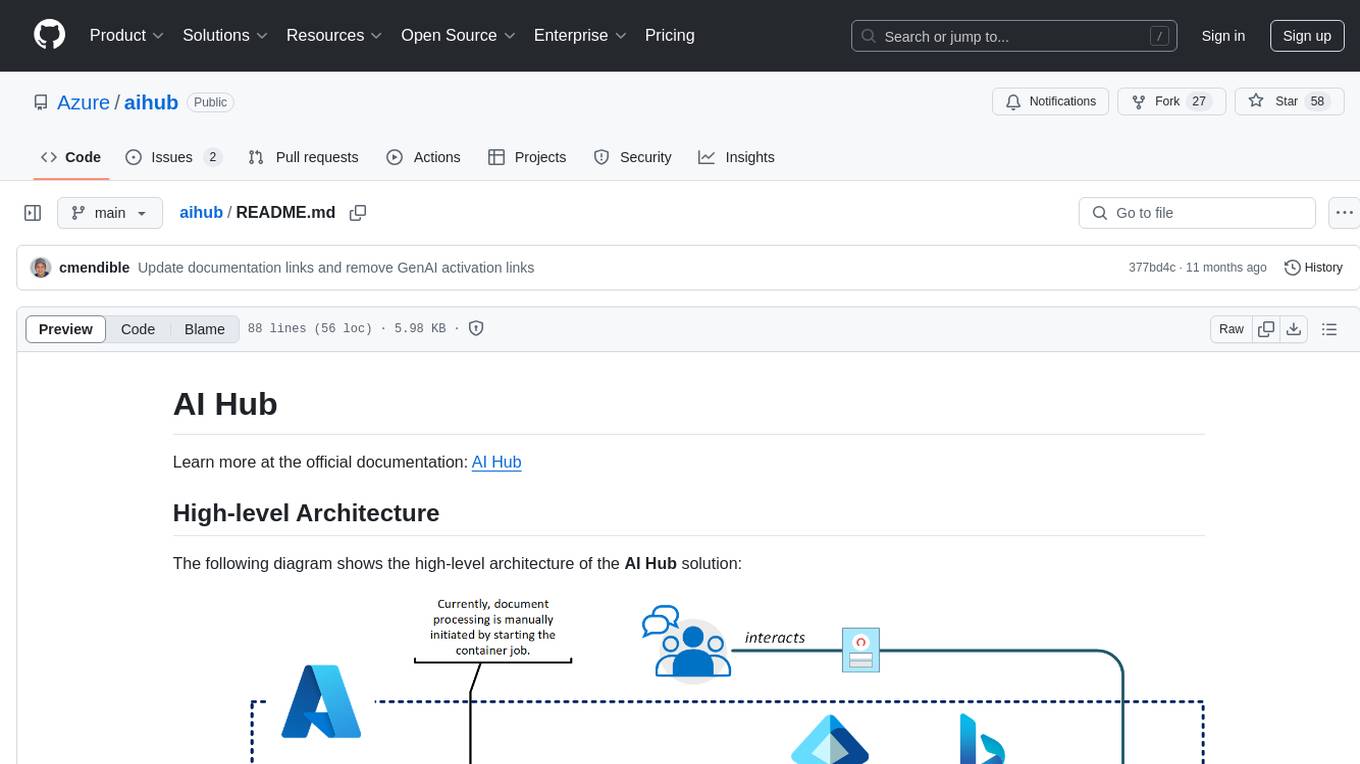
aihub
AI Hub is a comprehensive solution that leverages artificial intelligence and cloud computing to provide functionalities such as document search and retrieval, call center analytics, image analysis, brand reputation analysis, form analysis, document comparison, and content safety moderation. It integrates various Azure services like Cognitive Search, ChatGPT, Azure Vision Services, and Azure Document Intelligence to offer scalable, extensible, and secure AI-powered capabilities for different use cases and scenarios.
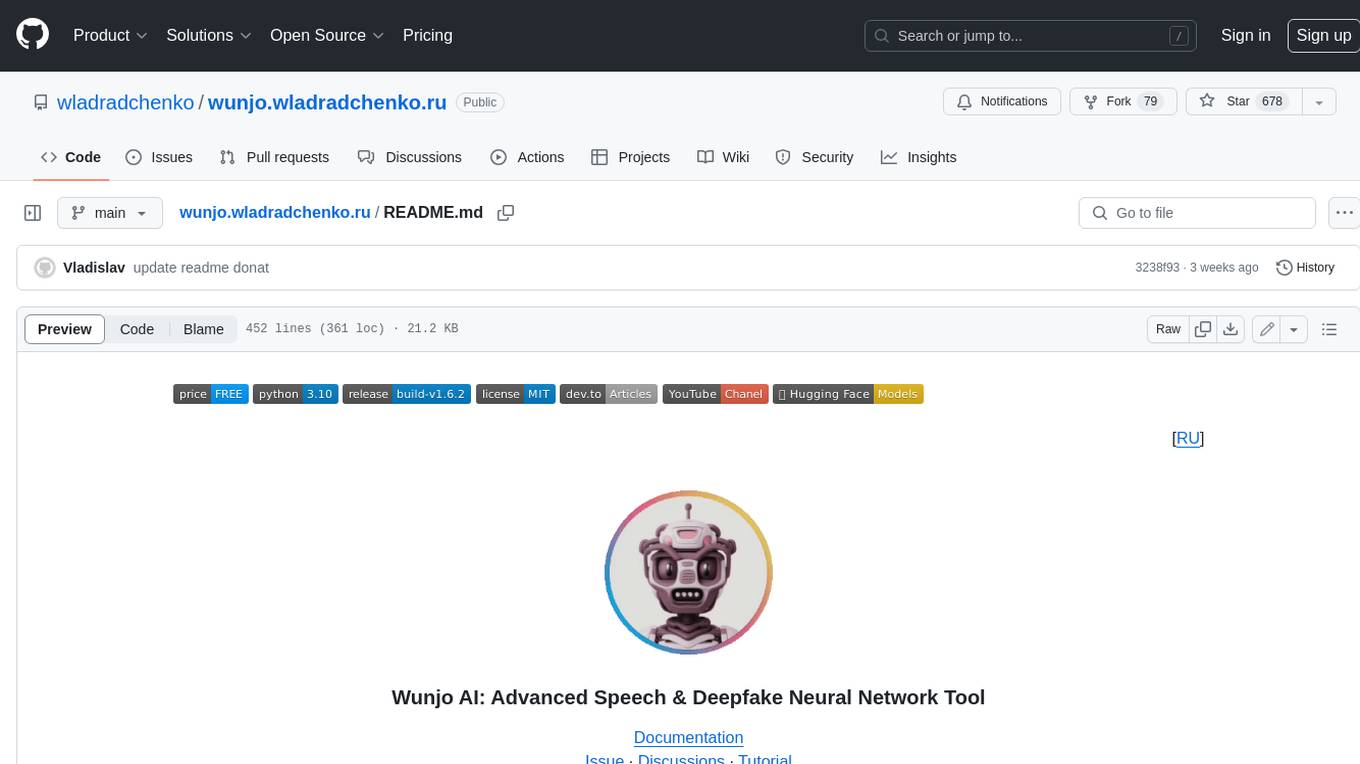
wunjo.wladradchenko.ru
Wunjo AI is a comprehensive tool that empowers users to explore the realm of speech synthesis, deepfake animations, video-to-video transformations, and more. Its user-friendly interface and privacy-first approach make it accessible to both beginners and professionals alike. With Wunjo AI, you can effortlessly convert text into human-like speech, clone voices from audio files, create multi-dialogues with distinct voice profiles, and perform real-time speech recognition. Additionally, you can animate faces using just one photo combined with audio, swap faces in videos, GIFs, and photos, and even remove unwanted objects or enhance the quality of your deepfakes using the AI Retouch Tool. Wunjo AI is an all-in-one solution for your voice and visual AI needs, offering endless possibilities for creativity and expression.
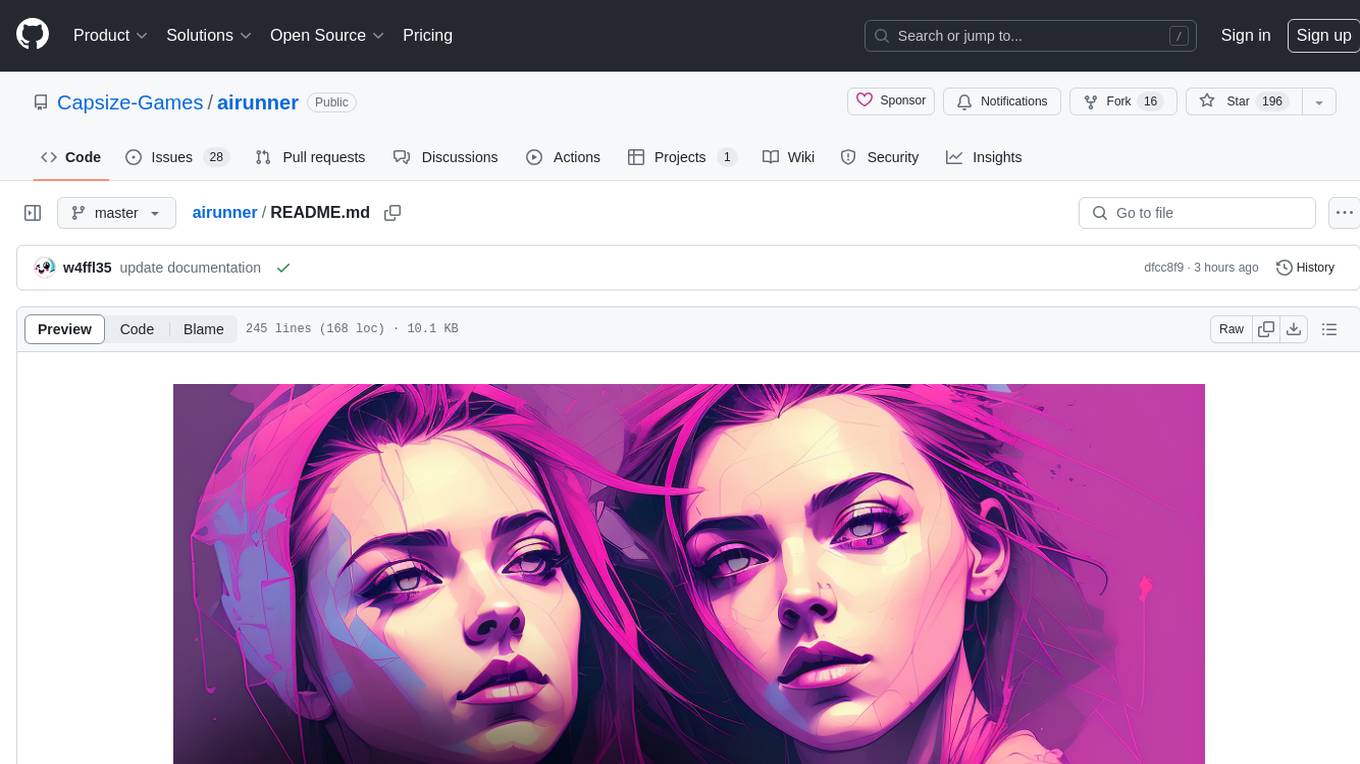
airunner
AI Runner is a multi-modal AI interface that allows users to run open-source large language models and AI image generators on their own hardware. The tool provides features such as voice-based chatbot conversations, text-to-speech, speech-to-text, vision-to-text, text generation with large language models, image generation capabilities, image manipulation tools, utility functions, and more. It aims to provide a stable and user-friendly experience with security updates, a new UI, and a streamlined installation process. The application is designed to run offline on users' hardware without relying on a web server, offering a smooth and responsive user experience.
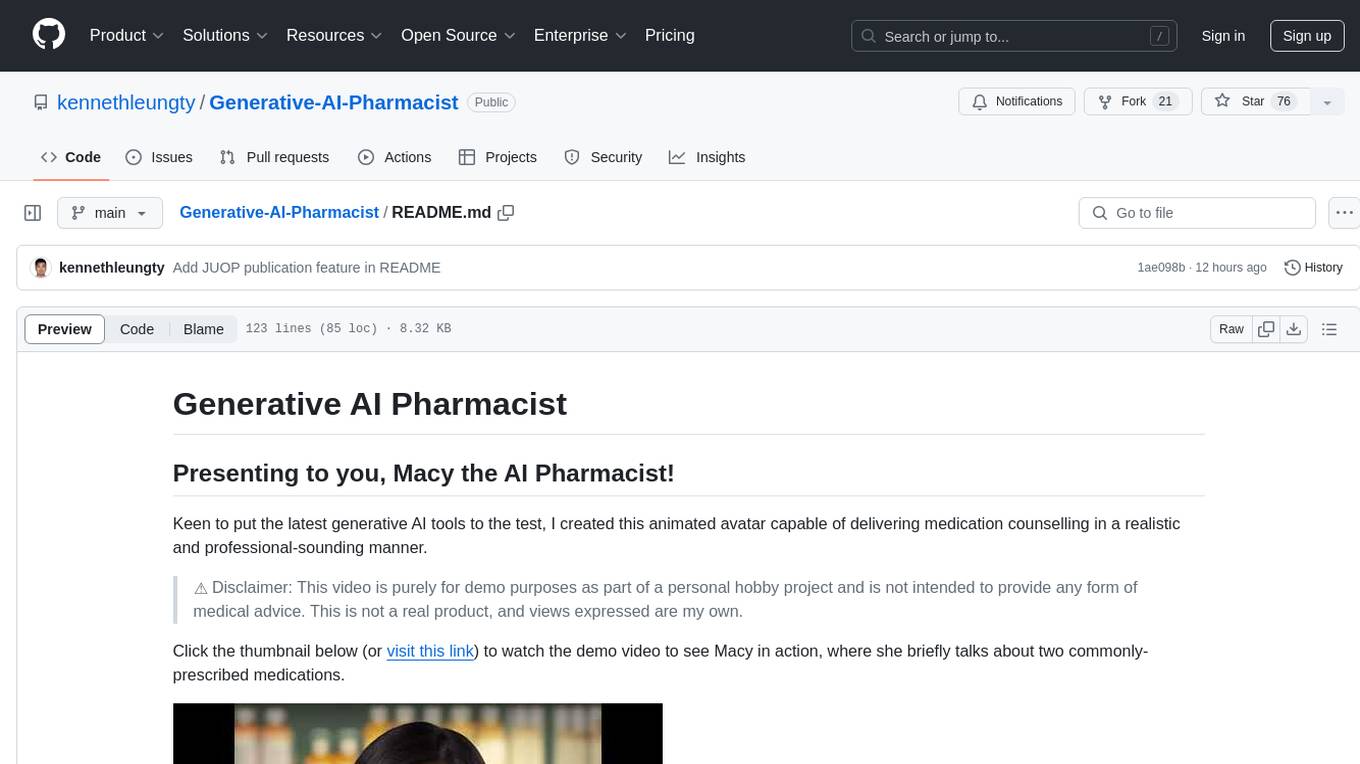
Generative-AI-Pharmacist
Generative AI Pharmacist is a project showcasing the use of generative AI tools to create an animated avatar named Macy, who delivers medication counseling in a realistic and professional manner. The project utilizes tools like Midjourney for image generation, ChatGPT for text generation, ElevenLabs for text-to-speech conversion, and D-ID for creating a photorealistic talking avatar video. The demo video featuring Macy discussing commonly-prescribed medications demonstrates the potential of generative AI in healthcare communication.
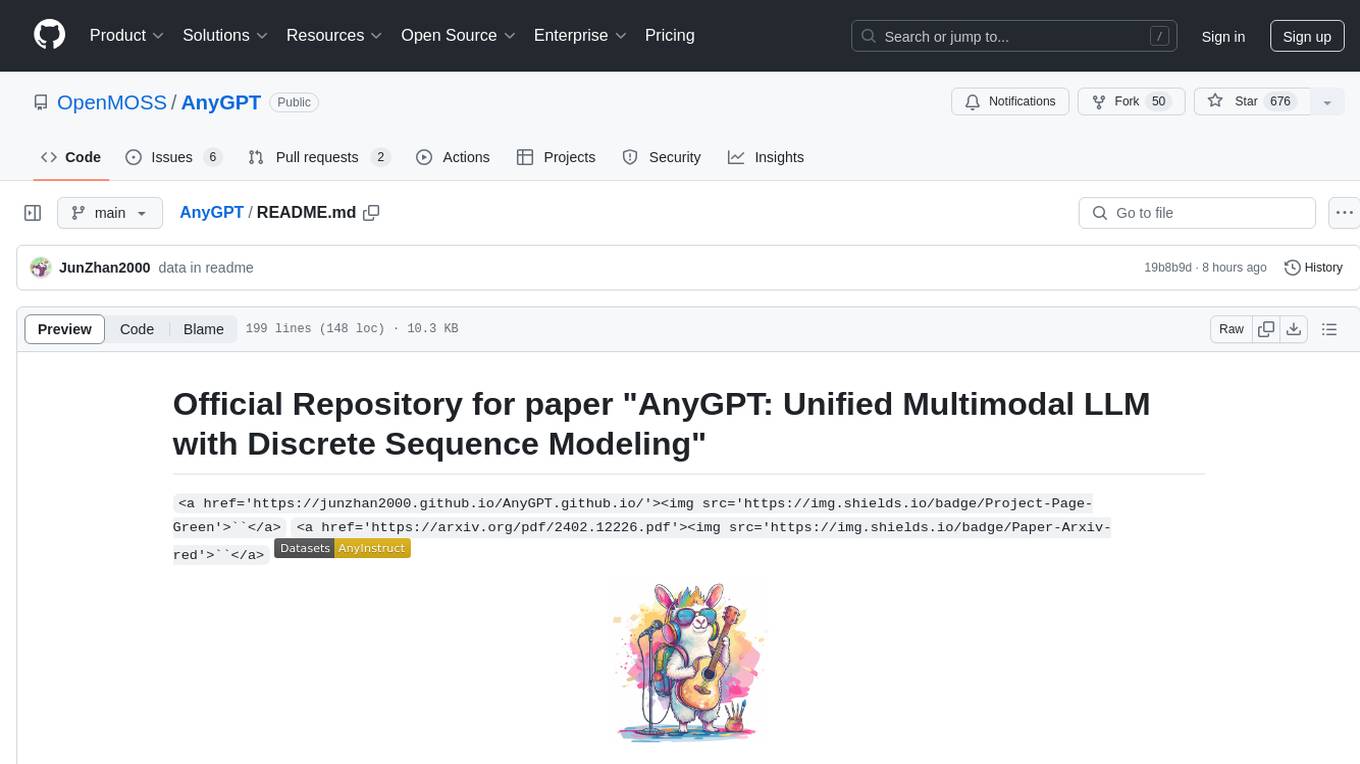
AnyGPT
AnyGPT is a unified multimodal language model that utilizes discrete representations for processing various modalities like speech, text, images, and music. It aligns the modalities for intermodal conversions and text processing. AnyInstruct dataset is constructed for generative models. The model proposes a generative training scheme using Next Token Prediction task for training on a Large Language Model (LLM). It aims to compress vast multimodal data on the internet into a single model for emerging capabilities. The tool supports tasks like text-to-image, image captioning, ASR, TTS, text-to-music, and music captioning.
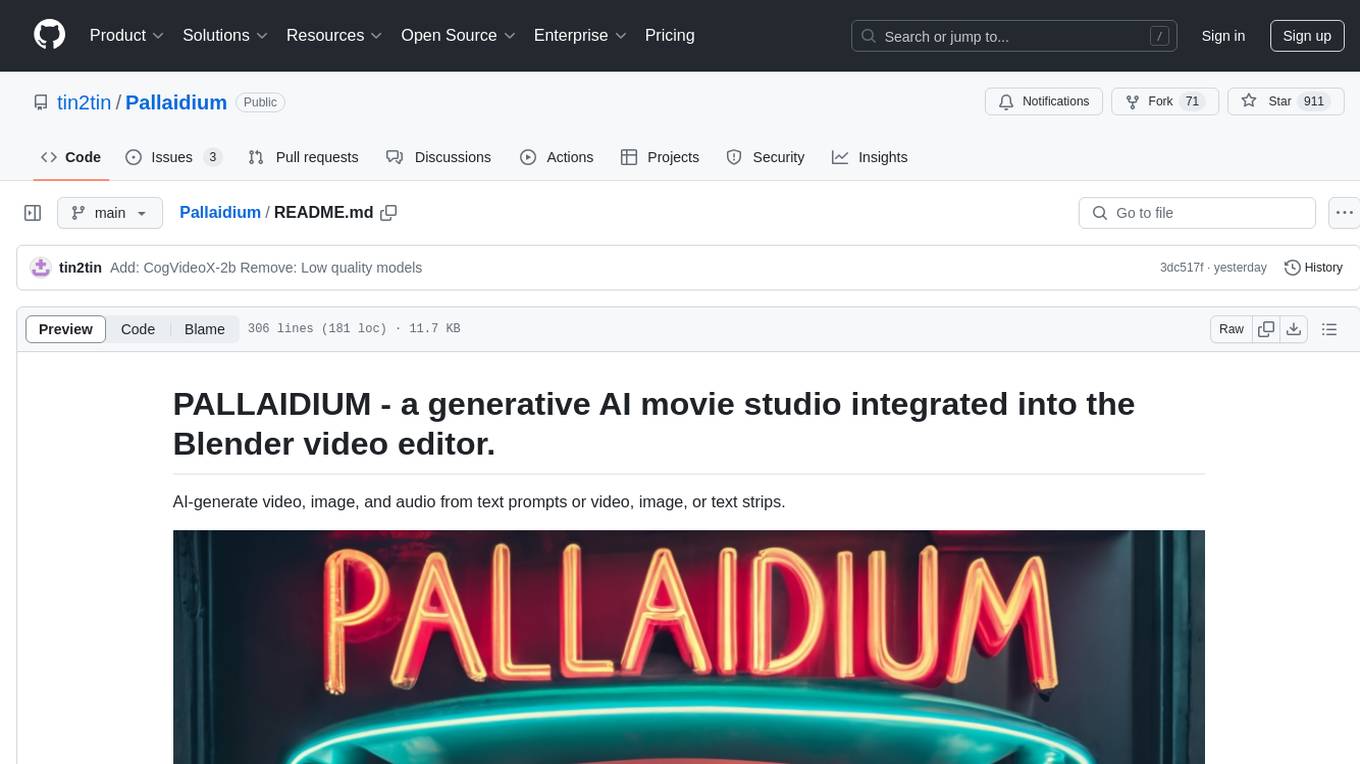
Pallaidium
Pallaidium is a generative AI movie studio integrated into the Blender video editor. It allows users to AI-generate video, image, and audio from text prompts or existing media files. The tool provides various features such as text to video, text to audio, text to speech, text to image, image to image, image to video, video to video, image to text, and more. It requires a Windows system with a CUDA-supported Nvidia card and at least 6 GB VRAM. Pallaidium offers batch processing capabilities, text to audio conversion using Bark, and various performance optimization tips. Users can install the tool by downloading the add-on and following the installation instructions provided. The tool comes with a set of restrictions on usage, prohibiting the generation of harmful, pornographic, violent, or false content.
ElevenLabs-DotNet
ElevenLabs-DotNet is a non-official Eleven Labs voice synthesis RESTful client that allows users to convert text to speech. The library targets .NET 8.0 and above, working across various platforms like console apps, winforms, wpf, and asp.net, and across Windows, Linux, and Mac. Users can authenticate using API keys directly, from a configuration file, or system environment variables. The tool provides functionalities for text to speech conversion, streaming text to speech, accessing voices, dubbing audio or video files, generating sound effects, managing history of synthesized audio clips, and accessing user information and subscription status.
For similar jobs

promptflow
**Prompt flow** is a suite of development tools designed to streamline the end-to-end development cycle of LLM-based AI applications, from ideation, prototyping, testing, evaluation to production deployment and monitoring. It makes prompt engineering much easier and enables you to build LLM apps with production quality.

deepeval
DeepEval is a simple-to-use, open-source LLM evaluation framework specialized for unit testing LLM outputs. It incorporates various metrics such as G-Eval, hallucination, answer relevancy, RAGAS, etc., and runs locally on your machine for evaluation. It provides a wide range of ready-to-use evaluation metrics, allows for creating custom metrics, integrates with any CI/CD environment, and enables benchmarking LLMs on popular benchmarks. DeepEval is designed for evaluating RAG and fine-tuning applications, helping users optimize hyperparameters, prevent prompt drifting, and transition from OpenAI to hosting their own Llama2 with confidence.
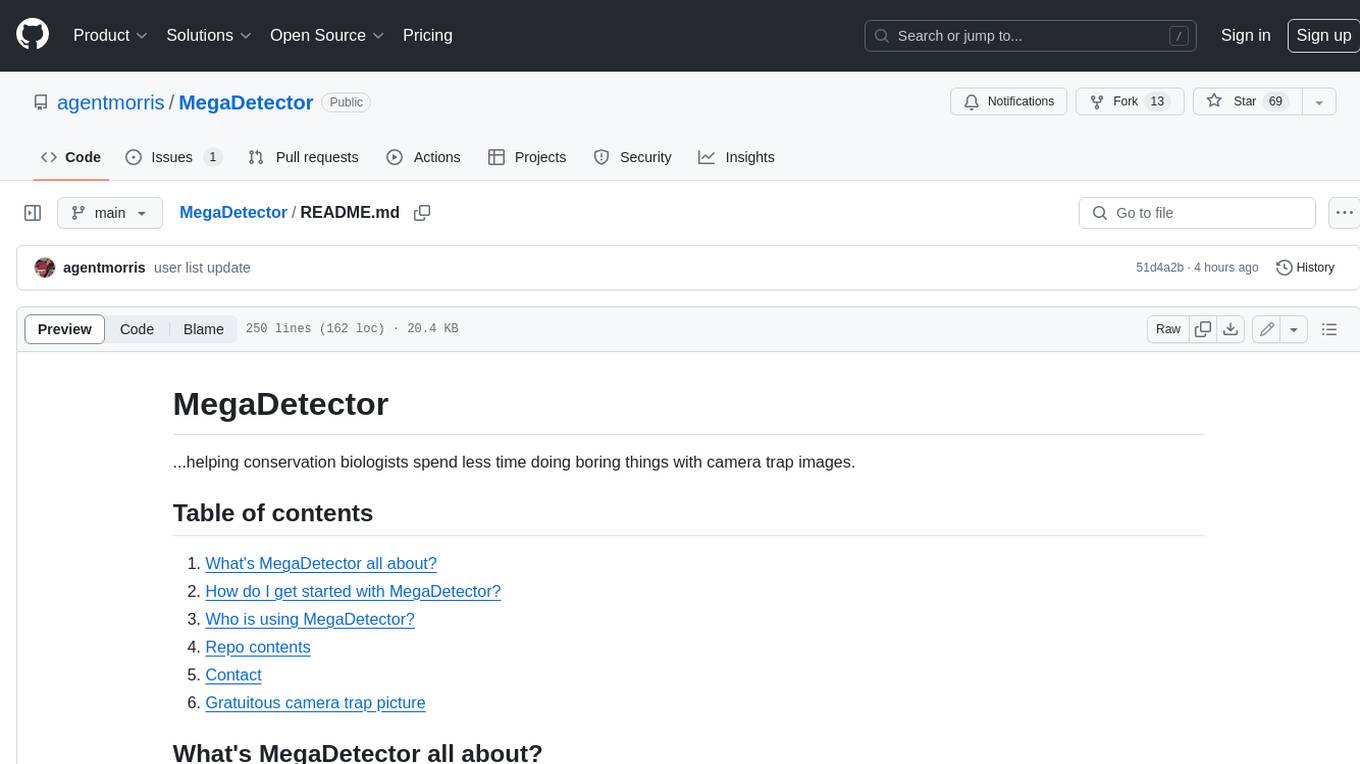
MegaDetector
MegaDetector is an AI model that identifies animals, people, and vehicles in camera trap images (which also makes it useful for eliminating blank images). This model is trained on several million images from a variety of ecosystems. MegaDetector is just one of many tools that aims to make conservation biologists more efficient with AI. If you want to learn about other ways to use AI to accelerate camera trap workflows, check out our of the field, affectionately titled "Everything I know about machine learning and camera traps".

leapfrogai
LeapfrogAI is a self-hosted AI platform designed to be deployed in air-gapped resource-constrained environments. It brings sophisticated AI solutions to these environments by hosting all the necessary components of an AI stack, including vector databases, model backends, API, and UI. LeapfrogAI's API closely matches that of OpenAI, allowing tools built for OpenAI/ChatGPT to function seamlessly with a LeapfrogAI backend. It provides several backends for various use cases, including llama-cpp-python, whisper, text-embeddings, and vllm. LeapfrogAI leverages Chainguard's apko to harden base python images, ensuring the latest supported Python versions are used by the other components of the stack. The LeapfrogAI SDK provides a standard set of protobuffs and python utilities for implementing backends and gRPC. LeapfrogAI offers UI options for common use-cases like chat, summarization, and transcription. It can be deployed and run locally via UDS and Kubernetes, built out using Zarf packages. LeapfrogAI is supported by a community of users and contributors, including Defense Unicorns, Beast Code, Chainguard, Exovera, Hypergiant, Pulze, SOSi, United States Navy, United States Air Force, and United States Space Force.

llava-docker
This Docker image for LLaVA (Large Language and Vision Assistant) provides a convenient way to run LLaVA locally or on RunPod. LLaVA is a powerful AI tool that combines natural language processing and computer vision capabilities. With this Docker image, you can easily access LLaVA's functionalities for various tasks, including image captioning, visual question answering, text summarization, and more. The image comes pre-installed with LLaVA v1.2.0, Torch 2.1.2, xformers 0.0.23.post1, and other necessary dependencies. You can customize the model used by setting the MODEL environment variable. The image also includes a Jupyter Lab environment for interactive development and exploration. Overall, this Docker image offers a comprehensive and user-friendly platform for leveraging LLaVA's capabilities.

carrot
The 'carrot' repository on GitHub provides a list of free and user-friendly ChatGPT mirror sites for easy access. The repository includes sponsored sites offering various GPT models and services. Users can find and share sites, report errors, and access stable and recommended sites for ChatGPT usage. The repository also includes a detailed list of ChatGPT sites, their features, and accessibility options, making it a valuable resource for ChatGPT users seeking free and unlimited GPT services.

TrustLLM
TrustLLM is a comprehensive study of trustworthiness in LLMs, including principles for different dimensions of trustworthiness, established benchmark, evaluation, and analysis of trustworthiness for mainstream LLMs, and discussion of open challenges and future directions. Specifically, we first propose a set of principles for trustworthy LLMs that span eight different dimensions. Based on these principles, we further establish a benchmark across six dimensions including truthfulness, safety, fairness, robustness, privacy, and machine ethics. We then present a study evaluating 16 mainstream LLMs in TrustLLM, consisting of over 30 datasets. The document explains how to use the trustllm python package to help you assess the performance of your LLM in trustworthiness more quickly. For more details about TrustLLM, please refer to project website.
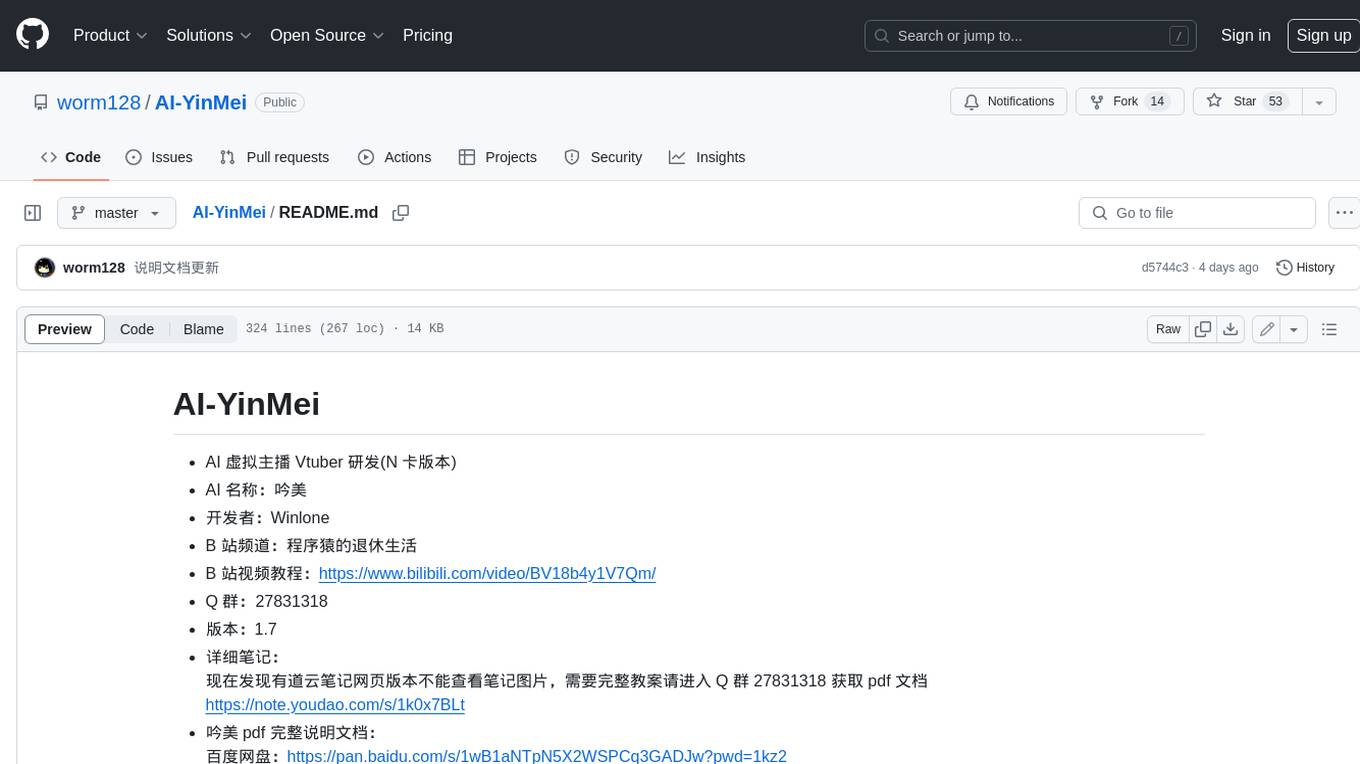
AI-YinMei
AI-YinMei is an AI virtual anchor Vtuber development tool (N card version). It supports fastgpt knowledge base chat dialogue, a complete set of solutions for LLM large language models: [fastgpt] + [one-api] + [Xinference], supports docking bilibili live broadcast barrage reply and entering live broadcast welcome speech, supports Microsoft edge-tts speech synthesis, supports Bert-VITS2 speech synthesis, supports GPT-SoVITS speech synthesis, supports expression control Vtuber Studio, supports painting stable-diffusion-webui output OBS live broadcast room, supports painting picture pornography public-NSFW-y-distinguish, supports search and image search service duckduckgo (requires magic Internet access), supports image search service Baidu image search (no magic Internet access), supports AI reply chat box [html plug-in], supports AI singing Auto-Convert-Music, supports playlist [html plug-in], supports dancing function, supports expression video playback, supports head touching action, supports gift smashing action, supports singing automatic start dancing function, chat and singing automatic cycle swing action, supports multi scene switching, background music switching, day and night automatic switching scene, supports open singing and painting, let AI automatically judge the content.





